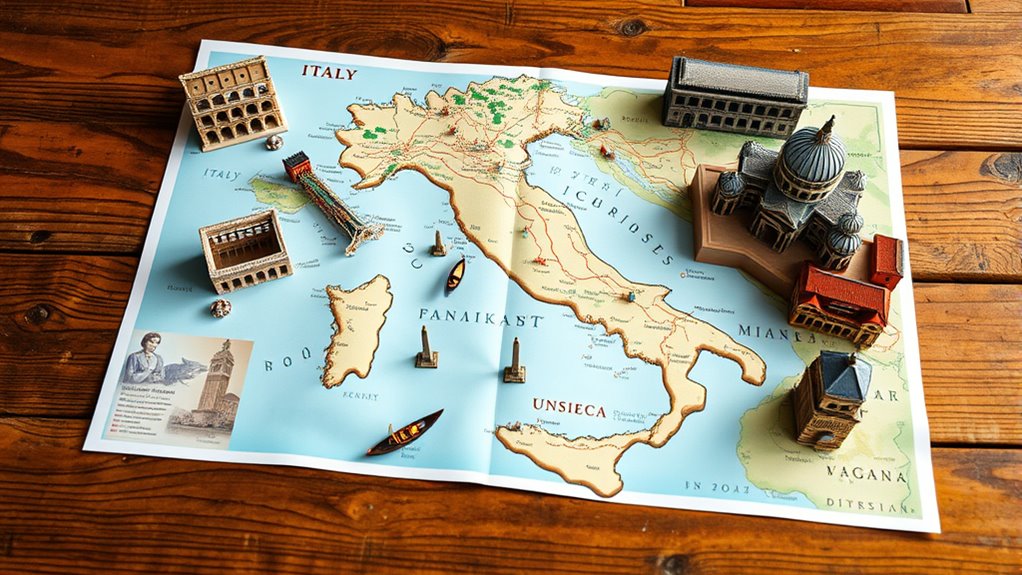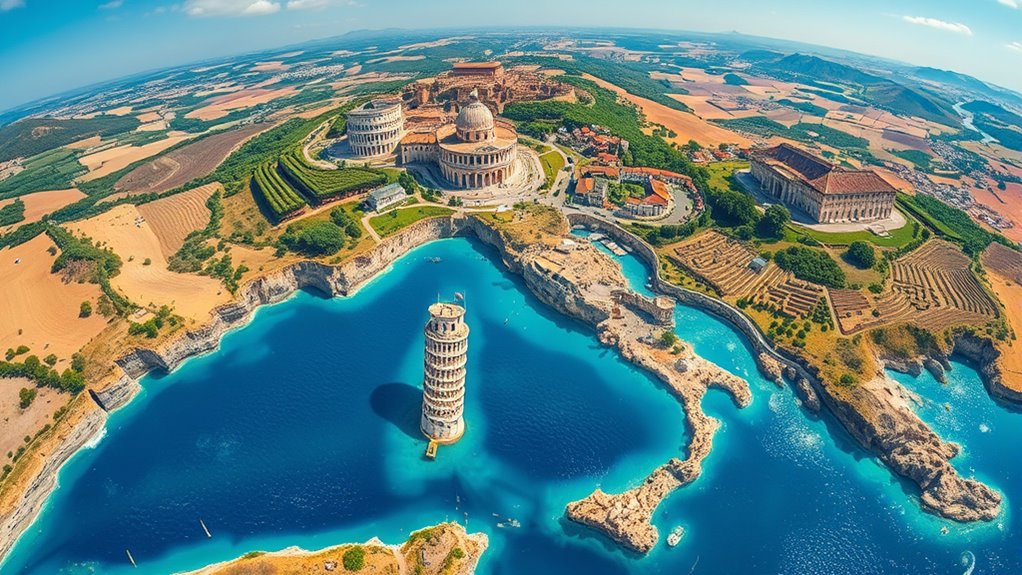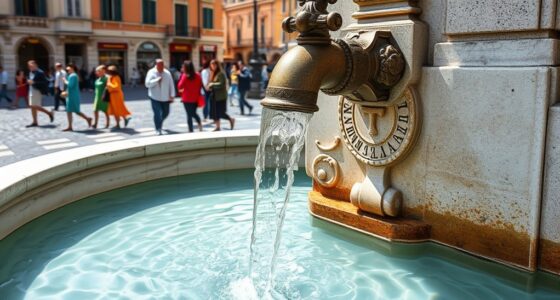Italy’s UNESCO World Heritage Sites map highlights a diverse mix of cultural and natural treasures that reflect the country’s rich history, art, and landscapes. As you explore the map, you’ll see how these sites connect to Italy’s heritage, traditions, and identity. They range from ancient ruins to breathtaking natural scenery, representing Italy’s ongoing cultural legacy. Keep exploring to discover more about these remarkable locations and their significance in shaping Italy’s unique story.
Key Takeaways
- Italy’s UNESCO sites showcase its rich cultural and natural heritage, highlighting ancient civilizations, art, and landscapes.
- The map illustrates the connection between Italy’s historic sites and local traditions, architecture, and cultural identity.
- It covers diverse attractions, from archaeological ruins like Pompeii to natural wonders like the Dolomites.
- The map emphasizes the layered significance of preservation, tourism, and cultural storytelling at each site.
- Engaging with the map promotes awareness of the importance of protecting Italy’s UNESCO sites for future generations.

Italy’s UNESCO World Heritage Sites map offers a fascinating glimpse into the country’s rich cultural and natural heritage. When you explore this map, you’re not just looking at points on a chart; you’re uncovering stories of ancient civilizations, artistic achievements, and breathtaking landscapes that define Italy’s identity. Each site represents more than just a popular tourist attraction—it’s an essential piece of the country’s local heritage. By understanding these sites, you gain insight into how Italy’s history and culture have shaped its communities over centuries.
Italy’s UNESCO sites reveal stories of civilizations, art, and landscapes shaping its rich heritage.
As you navigate the map, you’ll notice that many UNESCO sites are deeply connected to local heritage. These locations preserve traditions, architecture, and practices that are still alive today. For instance, in cities like Venice or Florence, the historic centers showcase Renaissance art and architecture that continue to influence modern life. Visiting these sites, you get a firsthand experience of the craftsmanship and cultural values passed down through generations. They’re not just relics; they’re living parts of Italy’s ongoing story. Recognizing this connection helps you appreciate the importance of preserving these sites as cultural treasures that embody local identity.
The map also highlights Italy’s diverse range of tourist attractions, from ancient ruins to natural wonders. You might find yourself drawn to the archaeological remains of Pompeii, where you can walk through a city frozen in time, or to the stunning landscapes of the Dolomites, which offer breathtaking vistas and outdoor adventures. Each UNESCO site serves as a magnet for travelers seeking unique experiences. But beyond the tourist appeal, these sites symbolize Italy’s commitment to safeguarding its natural and cultural assets. When you visit, you’re participating in a shared effort to protect these treasures for future generations.
Understanding Italy’s UNESCO World Heritage Sites map means recognizing the layered significance behind each location. It’s about seeing how local traditions and modern tourism intersect, creating a dynamic relationship between preservation and exploration. As you plan your visit, consider not just the sights but the stories and heritage they represent. By doing so, you enhance your experience and contribute to the ongoing appreciation of Italy’s remarkable legacy. Whether you’re marveling at ancient architecture or soaking in natural beauty, each site offers a meaningful connection to Italy’s past and present. This map isn’t just a guide; it’s an invitation to immerse yourself in Italy’s rich cultural tapestry. Additionally, understanding the importance of preservation of these sites helps ensure that future generations can enjoy and learn from Italy’s cultural and natural treasures.
Frequently Asked Questions
How Are UNESCO Sites Selected in Italy?
When considering UNESCO sites in Italy, you see that the process involves strict criteria selection and thorough site evaluation. You’ll find that sites must demonstrate outstanding universal value, meet cultural or natural criteria, and have authentic, well-preserved features. UNESCO experts assess these aspects carefully, ensuring each site deserves the designation. So, your favorite Italian landmarks become UNESCO sites only after they pass rigorous evaluation and meet the high standards set by the organization.
Are UNESCO Sites Open to the Public Year-Round?
You can generally visit UNESCO sites in Italy year-round, but be aware of access restrictions and seasonal closures that might apply. Some sites, especially those in remote or delicate areas, may have limited hours or be closed during certain seasons to preserve their condition. Always check ahead before planning your visit to guarantee you won’t encounter unexpected closures or restrictions, making your experience smooth and enjoyable.
Which UNESCO Sites Are Most Visited in Italy?
You’ll find that Italy’s most visited UNESCO sites, like the Colosseum and Venice, attract large tourist crowds year-round. These popular destinations draw many travelers, which helps fund conservation efforts but can also cause wear and tear. To enjoy these sites fully, visit during off-peak seasons. Your visits support preservation, ensuring future generations can experience Italy’s rich cultural heritage while managing the impact of heavy tourism.
How Does UNESCO Designation Impact Local Communities?
When a site receives UNESCO designation, it boosts community engagement by encouraging locals to participate in preservation efforts and tourism initiatives. This designation often drives economic development, creating jobs and supporting local businesses through increased visitor numbers. You’ll notice communities become more active in promoting their heritage, which reinforces cultural pride. Overall, UNESCO status helps local communities thrive by balancing tourism growth with preservation efforts, ensuring lasting benefits for residents and visitors alike.
Are There Any UNESCO Sites in Italy’S Smaller Towns?
They say, “Still waters run deep,” and Italy’s smaller towns truly hide gems worth exploring. Yes, many UNESCO sites are located in these charming places, promoting local preservation and cultural richness. You’ll find lesser-known towns with historic centers and archaeological sites that often go unnoticed but carry immense significance. Visiting these hidden gems allows you to experience Italy’s rich heritage firsthand, supporting local communities and preserving their unique traditions.
Conclusion
Exploring Italy’s UNESCO World Heritage Sites reveals a country rich in history and culture. Did you know Italy boasts 55 designated sites, more than any other nation? This impressive number highlights Italy’s incredible diversity, from ancient ruins to stunning landscapes. By understanding this map, you’ll gain a deeper appreciation for Italy’s heritage and the stories it holds. So, next time you visit, remember you’re walking through a living museum that spans millennia.









